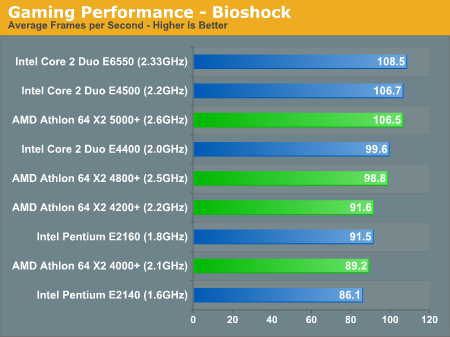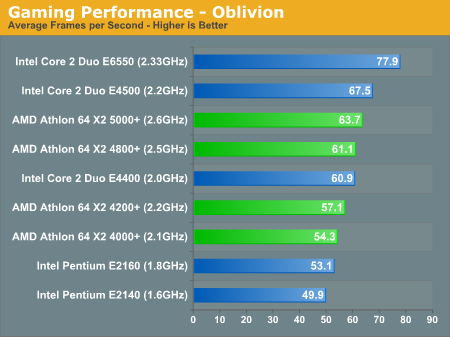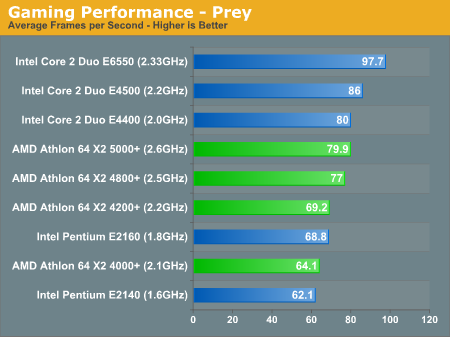Midrange CPU Roundup: It's Time to Buy
by Anand Lal Shimpi on September 28, 2007 2:00 AM EST- Posted in
- CPUs
Gaming with External Graphics
Thanks to dramatic improvements of integrated graphics chipsets over the years, they can perform just as well as their discrete counterparts in many benchmarks. However, modern 3D games aren't one of those benchmarks. If you decide to turn one of these midrange systems into a gaming box, all the motherboards we tested are equipped with a single x16 PCIe slot which will gladly accept a faster GPU.
If you're not GPU bound, how well do these CPUs perform in games? While slightly contrary to the point of this article, we'll answer that question. We tossed in a GeForce 8800 GTX to see how these platforms stack up in terms of CPU performance. Yes, that's more GPU than most midrange users are looking at purchasing, but we can be reasonably certain that we won't be GPU limited at the chosen 1024x768 resolution.
Bioshock is an Unreal Engine 3 based first person shooter with mostly indoor levels. We ran through a pre-defined path through one of the early levels using FRAPS to measure average frame rate. We tested Bioshock, as with all of the other titles, at 1024x768 with all of the visual options cranked up with the exception of AA which remained disabled.

The race honestly couldn't be closer between AMD and Intel; each competing pair performs identically making the choice really a tossup. The Core 2 Duo E4500 and 5000+ are equals, as are the E4000/4800+ and E2160/4000+.
Oblivion performance isn't really different; it's a tossup between AMD and Intel once again:

Supreme Commander is quite CPU bound, our benchmark runs a demo playback at 10x game speed and measures total execution time to get a good idea of CPU performance.

Intel is slightly ahead in the standings but not by a significant margin (generally less than 5%).

Prey, more of a classic first person shooter, gives us more of the standings we're used to with Intel holding onto a 7% performance advantage with the E4500 over the 5000+ and with the E2160 over the 4000+. The lower clock speed of the E4400 means that the 4800+ is closer to it, within around 3%.
Thanks to dramatic improvements of integrated graphics chipsets over the years, they can perform just as well as their discrete counterparts in many benchmarks. However, modern 3D games aren't one of those benchmarks. If you decide to turn one of these midrange systems into a gaming box, all the motherboards we tested are equipped with a single x16 PCIe slot which will gladly accept a faster GPU.
If you're not GPU bound, how well do these CPUs perform in games? While slightly contrary to the point of this article, we'll answer that question. We tossed in a GeForce 8800 GTX to see how these platforms stack up in terms of CPU performance. Yes, that's more GPU than most midrange users are looking at purchasing, but we can be reasonably certain that we won't be GPU limited at the chosen 1024x768 resolution.
Bioshock is an Unreal Engine 3 based first person shooter with mostly indoor levels. We ran through a pre-defined path through one of the early levels using FRAPS to measure average frame rate. We tested Bioshock, as with all of the other titles, at 1024x768 with all of the visual options cranked up with the exception of AA which remained disabled.

The race honestly couldn't be closer between AMD and Intel; each competing pair performs identically making the choice really a tossup. The Core 2 Duo E4500 and 5000+ are equals, as are the E4000/4800+ and E2160/4000+.
Oblivion performance isn't really different; it's a tossup between AMD and Intel once again:

Supreme Commander is quite CPU bound, our benchmark runs a demo playback at 10x game speed and measures total execution time to get a good idea of CPU performance.

Intel is slightly ahead in the standings but not by a significant margin (generally less than 5%).

Prey, more of a classic first person shooter, gives us more of the standings we're used to with Intel holding onto a 7% performance advantage with the E4500 over the 5000+ and with the E2160 over the 4000+. The lower clock speed of the E4400 means that the 4800+ is closer to it, within around 3%.










44 Comments
View All Comments
jonp - Sunday, September 30, 2007 - link
I too wonder about the Netburst admonition. There are probably millions of Netburst CPUs out there that are happily computing away with no thought of Anandtech at all; doing their thing; producing great results for their owners. The biggest concern I have seen is thermal and that, only in relation to overclocking. Assuming there are more than a few users that don't need to or want to overclock; then there are some great bargins in used Netburst Processors and accompanying motherboards.It doesn't appear to me that "...if you know what's best for you." is either technical, professional or helpful. Maybe it was meant as a joke...sorry it's not that funny.
HotdogIT - Friday, September 28, 2007 - link
Yes, you did. Given the combination of power usage savings, pure performance benefits, and overclocking ability (since you mentioned 3.6ghz on the Pentium D, I assume we can go with at least 2.4 out of an e2140, for comparisons sake), the C2D/Pentium E line is much better.
The problem with a lot of the "lol Pentium D overclocking" articles is they fail to overclock what they're comparing against. You take a Pentium D 805 and OC it to 4ghz, sure, the performance delta over an e2140 will be big. But apply the same cooling and thought into OCing the e2140, and that delta will swing the other way.
ThatLukeGuy - Saturday, September 29, 2007 - link
So what would make the most sense to change out the Pentium D805 to that would keep me at (or better yet raise the bar of) the performance I'm getting now? An OC'd e2140 or something higher up the ladder? I'm matching this to a 2gigs ram, an nice MSI SLI plat mobo, and an 8800gts320mb. I'd want something that wouldn't bottleneck the system which is what the P.D805 did when it was stock.
HotdogIT - Sunday, September 30, 2007 - link
It's going to depend on a lot of factors. If you're gaming, a change in the CPU may very well do very little in changing any performance; especially at a higher resolution, the CPU may make NO difference.
I'd look into the e2140/e2160/e4X00 line, if you wanted to stay lower cost. At the VERY least, you'll get a boost in energy efficency: The Pentium Ds were and are power hogs, especially compared to the newer line.
What performance did you see increase when you overclocked the Pentium D? Did gaming increase? If so, then a C2D based system would be much better, regardless of an overclock; Netburst just don't handle the games as well.
If, somehow, you're running something that is AMAZINGLY well tuned for Netburst, you may see less of an increase. But these applications are rare these days, so I doubt you'd see that in most cases.
Parhelion69 - Friday, September 28, 2007 - link
Anand did you do the power consumption tests on the overclocked cpus? I think it's important to know, if you haven't, can't you at least give us a rought estimation? It'd be greatly appreciated. Thanks.dm0r - Friday, September 28, 2007 - link
Thats a great article Anand, I missed this kind of roundup.Enjoyed a lot and the only thing is missing is the performance per watt, but anyway very good article.Thanks for sharing!eetnoyer - Friday, September 28, 2007 - link
Why not throw in the 4200+? I know it's 90nm, but I just got one for $74, and (for me)it looks like the sweet spot of price/performance for AMD. And, given how well tuned their 90nm process is at EOL, I wouldn't be surprised to see power consumption close to that of the 65nm chips. If you want, you could use the 65W version (it's only a buck more).Uter - Friday, September 28, 2007 - link
Anand, is the BE-2400 still coming out? Or, when you say that there are two Athlon X2 BE Processors, the BE-2350 and BE-2300, is that a subtle hint that we shouldn't expect to see it? I just want to make sure I pick one of these up while there are still available...bogda - Friday, September 28, 2007 - link
Oveclocking results are not fair. You chose horrible motherboards for AMD overclocking.For example, Biostar AMD motherboards cost 50-60 euros. They are much better overclockers than MSI or ASUS you chose. My Athlon BE-2300 easily overclocks from default 1,9GHz to over 2,8GHz with stock HSF.
wdb1966 - Sunday, September 30, 2007 - link
I completely agree, the boards chosen for the AMD chips are horrible.Gigabyte's MA69GM-S2H and Abit's NF-M2 nView would have been far superior choices in every way...poor motherboard choices, very poor.